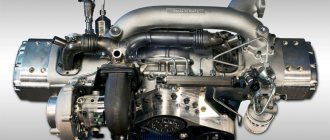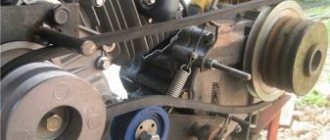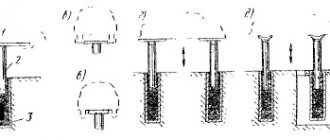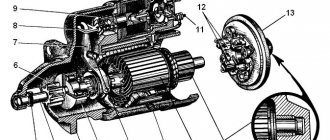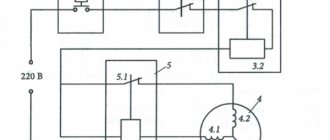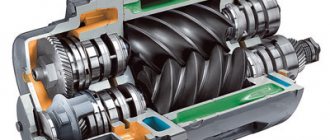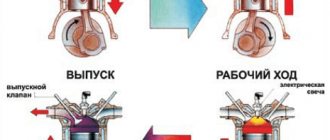In order for a car to move independently, it must be equipped with a power unit that will generate torque and transmit this force to the drive wheels. For this purpose, the creators of mechanical means developed the internal combustion engine or internal combustion engine.
The principle of operation of the unit is that in its design a mixture of fuel and air is burned. The motor is designed to use the energy released in this process to rotate the wheels.
Under the hood of a modern car, a gasoline, diesel or electric power unit can be installed. In this review, we will focus on the gasoline modification: on what principle does the unit operate, what kind of design does it have, and some practical recommendations on how to extend the life of the internal combustion engine.
What is a gasoline car engine
First, let's understand the terminology. A gasoline engine is a piston power unit that operates by burning a mixture of air and gasoline in cavities specially designated for this purpose. The car can be filled with fuel with different octane numbers (A92, A95, A98, etc.). More details about what octane number is can be found in another article . It also explains why different engines may rely on different brands of fuel, even if it is gasoline.
Depending on what goal the automaker is pursuing, vehicles coming off the assembly line can be equipped with different types of power units. The list of reasons includes the company's marketing (every new car must receive some kind of update, and buyers often pay attention to the type of power unit), as well as the needs of the main audience.
So, a car brand’s factory may leave the same car model, but with different gasoline engines. For example, it could be an economical version, which is more often paid attention to by buyers with modest incomes. Or the manufacturer can offer more dynamic modifications that satisfy the needs of fast driving enthusiasts.
Also, some cars should be able to transport decent loads, such as pickups (what is special about this type of body, read separately ). These cars also require a different type of engine. a separate review on how this parameter is calculated ).
So, gasoline engines enable car brands to create car models with different technical characteristics in order to adapt them to different needs, ranging from small city cars to large trucks.
Modern developments
The main task that automakers are struggling with is reducing fuel consumption and emissions of harmful substances into the atmosphere. Therefore, they are constantly improving the power supply system, the result is the recent emergence of direct injection injection systems.
Alternative types of fuel are being sought; the latest development in this direction so far is the use of alcohols and vegetable oils as fuel.
Scientists are also trying to establish the production of engines with a completely different operating principle. This, for example, is the Wankel engine, but so far there has been no particular success.
Types of gasoline engines
Advertising brochures for new car models contain a lot of different information. Among them, the type of power unit is described. If in the first cars it was enough to indicate the type of fuel used (diesel or gasoline), today there is a wide variety of gasoline modifications.
Here are several categories into which such power units are classified:
- Number of cylinders. In the classic version, the car is equipped with a four-cylinder engine. More productive, and at the same time more voracious, have 6, 8 or even 18 cylinders. However, there are also units with a small number of boilers. For example, Toyota Aygo is equipped with a 1.0-liter petrol engine with 3 cylinders. The Peugeot 107 also received a similar unit. Some small cars can even be equipped with a two-cylinder gasoline unit.
- The structure of the cylinder block. In the classic version (4-cylinder modification), the engine has an in-line arrangement of cylinders. Mostly they are installed vertically, but sometimes there are also inclined analogues. The next design that has won the trust of many motorists is a unit with a V-shaped cylinder arrangement. In this modification there is always a pair of pots, which are located at a certain angle relative to each other. Often this design is used to save space in the engine compartment, especially if it is a large engine (for example, it has 8 cylinders, but takes up space like a 4-cylinder analogue).
Some manufacturers install a W-shaped power unit in their cars. This modification differs from the V-shaped analogue by the additional camber of the cylinder block, which in cross-section has the shape of the letter W. Another type of engine that is used in modern cars is a boxer or boxer. Details about how such an engine is designed and how it works are described in another review . An example of models with a similar unit is Subaru Forester, Subaru WRX, Porsche Cayman, etc. - Fuel supply system. According to this criterion, engines are divided into two categories: carburetor and injection. In the first case, gasoline is pumped into the fuel chamber of the mechanism, from which it is sucked into the intake manifold through a nozzle. An injector is a system that forcibly sprays gasoline into the cavity in which the nozzle is installed. The operation of this device is described in detail here . There are several types of injectors, which differ in the location of the nozzles. In more expensive cars, nozzles are installed directly in the cylinder head.
- Type of lubrication system. Each internal combustion engine operates under conditions of increased loads, which is why it needs high-quality lubrication. There is a modification with a wet (classic type, in which the oil is in a sump) or dry (a separate tank is installed for storing oil) sump. These varieties are described in detail separately.
- Cooling type. Most modern car engines are water cooled. In the classic version, such a system will consist of a radiator, pipes and a cooling jacket around the cylinder block. The operation of this system is described here . Some modifications of gasoline-powered power units may also be air-cooled.
- Type of cycles. There are two modifications in total: two-stroke or four-stroke type. The operating principle of the two-stroke modification is described in another article . A little later we will look at how the 4-stroke model works.
- Type of air intake. Air can be supplied to the intake tract to prepare the air-fuel mixture in two ways. Most classic internal combustion engine models have an atmospheric intake system. Air enters it due to the vacuum created by the piston, moving to the bottom dead center. Depending on the injection system, a portion of gasoline is sprayed into this stream either before the intake valve, or a little earlier, but in a path corresponding to a specific cylinder. In mono-injection, like a carburetor modification, one nozzle is installed on the intake manifold, and the VTS is then sucked into a specific cylinder. The operation of the intake system is described in detail Here. In more expensive units, gasoline can be sprayed directly into the cylinder itself. In addition to the naturally aspirated engine, there is also a turbocharged version. In it, the air for preparing the HTS is pumped using a special turbine. It can work due to the movement of exhaust gases or using an electric motor.
As for the design features, history knows several exotic power units. Among them are the Wankel engine and a valveless model. Several working models of motors with unusual designs are described in detail here .
Gas distribution mechanism
The task of this mechanism is to timely supply the combustible mixture or its components to the cylinder, as well as to remove combustion products.
Two-stroke engines do not have a mechanism as such. In it, the supply of the mixture and the removal of combustion products is carried out by technological windows, which are made in the walls of the sleeve. There are three such windows - inlet, bypass and outlet.
The piston, moving, opens and closes one or another window, and this fills the sleeve with fuel and removes exhaust gases. The use of such gas distribution does not require additional components, therefore the cylinder head of such an engine is simple and its task is only to ensure the tightness of the cylinder.
The 4-stroke engine has a valve timing mechanism. The fuel in such an engine is supplied through special holes in the head. These holes are closed with valves. When it is necessary to supply fuel or remove gases from the cylinder, the corresponding valve is opened. The opening of the valves is ensured by the camshaft, which at the right moment presses on the required valve with its cams and it opens the hole. The camshaft is driven by the crankshaft.
Timing belt and chain drive
The layout of the gas distribution mechanism may vary. Engines are produced with a lower camshaft (located in the cylinder block) and an overhead valve (in the cylinder head). The transmission of force from the shaft to the valves is carried out through rods and rocker arms.
More common are motors in which both the shaft and valves are located at the top. With this arrangement, the shaft is also located in the cylinder head and it acts on the valves directly, without intermediate elements.
The principle of operation of a gasoline engine
The vast majority of internal combustion engines used in modern cars operate on a four-stroke cycle. It is based on the same principle as any other internal combustion engine. In order for the unit to generate the amount of energy required to rotate the wheels, each cylinder must be cyclically filled with a mixture of air and gasoline. This portion must be compressed, after which it is ignited using a spark generated by a spark plug .
In order for the energy released during combustion to be converted into mechanical energy, the HTS must be burned in a confined space. The main element that removes the released energy is the piston. It is movable in the cylinder and is attached to the crank mechanism of the crankshaft.
When the air-fuel mixture ignites, it causes the gases in the cylinder to expand. Due to this, a large pressure exceeding atmospheric pressure is exerted on the piston, and it begins to move towards the bottom dead center, turning the crankshaft. A flywheel is attached to this shaft, to which the gearbox is connected. From it, torque is transmitted to the drive wheels (front, rear, or in the case of an all-wheel drive car - all 4).
During one engine cycle, 4 strokes are performed in a separate cylinder. This is what they do.
Inlet
At the beginning of this stroke, the piston is at top dead center (the chamber above it is empty at this moment). Due to the work of neighboring cylinders, the crankshaft rotates and pulls the connecting rod, which moves the piston down. At this moment, the gas distribution mechanism opens the intake valve (there may be one or two).
Through the open hole, the cylinder begins to be filled with a fresh portion of the air-fuel mixture. In this case, air is mixed with gasoline in the intake tract (carburetor engine or model with distributed injection). This part of the engine may have a different design. There are also options that change their geometry, which allows you to increase engine efficiency at different speeds. This system is described in detail here .
In versions with direct injection, only air enters the cylinder during the intake stroke. Gasoline is sprayed when the compression stroke of the cylinder is completed.
When the piston is at the very bottom of the cylinder, the gas distribution mechanism closes the intake valve. The next beat begins.
Compression
Next, the crankshaft rotates (also under the action of the pistons operating in adjacent cylinders), and the piston begins to lift through the connecting rod. All valves in the cylinder head are closed. The fuel mixture has nowhere to go and is compressed.
As the piston moves toward TDC, the air-fuel mixture heats up (increasing temperature provokes strong compression, also called compression). The compression force of the VTS portion affects the dynamic characteristics. Compression may differ for different engines. Additionally, we suggest that you familiarize yourself with the difference between the degree of compression and compression .
When the piston reaches its highest point, the spark plug creates a discharge that causes the fuel mixture to ignite. Depending on the engine speed, this process may begin before the piston has fully risen, immediately at this moment or a little later.
In a direct injection gasoline engine, only air is compressed. In this case, fuel is sprayed into the cylinder before the piston rises. After this, a discharge is created and the gasoline begins to burn. Then the third beat begins.
Working stroke
When the VTS is ignited, combustion products expand in the space above the piston. At this moment, in addition to the force of inertia, the pressure of the expanding gases begins to act on the piston, and it moves down again. Unlike the intake stroke, mechanical energy is no longer transferred from the crankshaft to the piston, but vice versa - the piston pushes the connecting rod and, as a result, turns the crankshaft.
Some of this energy is used to perform other strokes in adjacent cylinders. The rest of the torque is removed by the gearbox and transmitted to the drive wheels.
During the power stroke, all valves are closed so that the expanding gases act exclusively on the piston. This stroke ends when the element moving in the cylinder reaches bottom dead center. Then the last beat of the cycle begins.
Release
By turning the crankshaft, the piston moves up again. At this moment, the exhaust valve opens (one or two depending on the type of timing belt). Exhaust gases must be removed.
As the piston moves upward, exhaust gases are forced into the exhaust tract. More information about its function is described here . The stroke ends at the top position of the piston. At this point the engine cycle ends and a new one begins with the intake stroke.
The completion of a stroke is not always accompanied by the complete closure of a particular valve. It happens that the intake and exhaust valves remain open for some time. This is necessary to increase the efficiency of ventilation and filling of the cylinders.
So, the linear movement of the piston is converted into rotation due to the design features of the crankshaft. All classic piston engines are based on this principle.
If a diesel unit runs only on diesel fuel, then the gasoline version can run not only on gasoline, but also on gas (propane-butane). More details about how such an installation will work are described here .
crank mechanism
The crank mechanism, which is part of the engine design, ensures the conversion of the reciprocating movement of the piston in the sleeve into rotational movement of the crankshaft. The main element of this mechanism is the crankshaft. It has a movable connection to the cylinder block. This connection ensures rotation of this shaft around its axis.
A flywheel is attached to one end of the shaft. The flywheel's job is to transmit torque from the shaft further. Since a 4-stroke engine has only one half-turn with useful action per two revolutions of the crankshaft - the power stroke, the rest require reverse action, which is performed by the flywheel. Having significant mass and rotating, due to its kinetic energy it ensures rotation of the knees. shaft during preparatory strokes.
Flywheel device
The flywheel circle has a toothed ring, which is used to start the power plant.
On the other side of the shaft there is a drive gear for the oil pump and gas distribution mechanism, as well as a flange for attaching the pulley.
This mechanism also includes connecting rods, which transmit force from the piston to the crankshaft and back. The connecting rods are also attached to the shaft movably.
Surfaces of the cylinder block, knees. The shaft and connecting rods do not directly contact each other at the joints; between them there are sliding bearings - liners.
Basic elements of a gasoline engine
In order for all engine strokes to be performed in a timely manner and with maximum efficiency, the power unit must consist only of high-quality parts. The design of all piston internal combustion engines includes the following parts.
Cylinder block
Essentially, this is the body of a gasoline engine, in which the cooling jacket channels, places for attaching studs, and the cylinders themselves are made. There are modifications with separately installed cylinders.
Basically, this part is made of cast iron, but in order to save weight on some car models, manufacturers can make aluminum blocks. Compared to the classic analogue, they are more fragile.
Piston
This part, which is part of the cylinder-piston group, takes on the impact of expanding gases and provides pressure on the crankshaft crank. When the intake, compression and exhaust strokes are performed, this part creates a vacuum in the cylinder, compresses the mixture of gasoline and air, and also removes combustion products from the cavity.
The structure, varieties and principle of operation of this element are described in detail in another review . In short, on the valve side it can be smooth or with grooves. From the outside it is connected with a steel pin to the connecting rod.
To prevent exhaust gases from leaking into the sub-piston space when the exhaust gases are pushed during the power stroke, this part is equipped with several o-rings. a separate article about their function and design .
connecting rod
This part connects the piston to the crankshaft crank. The design of this element depends on the type of engine. For example, a V-shaped engine has two connecting rods for each pair of cylinders mounted on one crankpin.
Mostly high-strength steel is used to make this part, but sometimes aluminum analogues are also found.
Crankshaft
This is a shaft that consists of cranks. Connecting rods are connected to them. The crankshaft has at least two main bearings and counterweights that compensate for vibrations to ensure uniform rotation of the shaft axis and dampen inertial forces. The design of this part is described in more detail separately .
On one side, a timing drive pulley is installed on it. A flywheel is attached to the crankshaft on the opposite side. Thanks to this element, it is possible to start the engine using a starter.
Valves
Valves are installed in the cylinder head at the top of the engine . These elements ensure the opening/closing of the inlet and outlet ports to perform the desired stroke.
In most cases, these parts are spring loaded. They are driven by the timing camshaft. This shaft is synchronized with the crankshaft using a belt or chain drive.
Spark plug
Many motorists know that a diesel engine works by heating the air compressed in the cylinder. When diesel fuel is injected into this environment, the air-fuel mixture immediately ignites due to air temperature. With a gasoline unit the situation is different. For the mixture to ignite, it needs an electric spark.
If in a gasoline internal combustion engine the compression is increased to a value close to that in a diesel engine, then, having a higher octane number, gasoline may ignite earlier than necessary when it is very hot. This will lead to damage to the unit.
The spark plug is powered by the ignition system. Depending on the car model, this system may have a different design. The varieties are described in detail here .
Gasoline engine auxiliary operating systems
No internal combustion engine is capable of operating independently without auxiliary systems. In order for the car engine to start at all, it must be synchronized with the following systems:
- Fuel It ensures the supply of gasoline through the line to the injectors (if it is an injection unit) or to the carburetor. This system is involved in the preparation of military technical equipment. In modern cars, the composition of the air-fuel mixture is controlled electronically.
- Ignition. This is the electrical part that supplies the engine with a stable spark for each cylinder. There are three main types of these systems: contact, non-contact and microprocessor type. They all determine the moment when a spark is needed, generate high voltage and distribute the impulse to the appropriate spark plug. Neither of these systems will work if the crankshaft position sensor .
- Lubricating and cooling. In order for engine parts to withstand heavy loads (constant mechanical load and exposure to very high temperatures, in some areas it rises to more than 1000 degrees), they need high-quality and constant lubrication, as well as cooling. These are two different systems, but the lubrication in the engine also allows, to some extent, to remove heat from very hot parts, for example, from pistons.
- Exhaust To prevent a car with a running engine from frightening others with a deafening sound, it receives a high-quality exhaust system. In addition to the quiet operation of the machine, this system ensures the neutralization of harmful substances contained in the exhaust (for this, the machine must have a catalytic converter ).
- Gas distribution. This is part of the engine (the timing belt is located in the cylinder head). The camshaft alternately opens the intake/exhaust valves, so that the cylinders perform the appropriate stroke on time.
These are the main systems thanks to which the unit can operate. In addition to them, the power unit can receive other mechanisms that increase its efficiency. An example of this is a phase shifter. This mechanism allows you to achieve maximum efficiency at any engine speed. It regulates the height and opening time of the valves, which affects the dynamics of the car. The operating principle and types of such mechanisms are discussed in detail separately .
Cylinder-piston group
This group consists of cylinder liners, pistons, piston rings and pins. It is in this group that the combustion process takes place and the energy released is transferred for conversion. Combustion occurs inside the liner, which is closed on one side by the block head and on the other by the piston. The piston itself can move inside the liner.
To ensure maximum tightness inside the liner, piston rings are used to prevent the mixture and combustion products from leaking between the walls of the liner and the piston.
The piston is movably connected to the connecting rod by means of a pin.
How to maintain the performance of a gasoline engine after many years of operation?
Every car owner thinks about how to extend the working life of the power unit of their car. Before we look at what it can do for this, it is worth considering the most important factor affecting the health of the motor. This is the build quality and technology that the automaker uses when producing this or that power unit.
Here are the basic actions that every motorist must perform:
- Carry out maintenance of your car in accordance with the regulations established by the manufacturer;
- Fill the tank only with high-quality gasoline that matches the type of engine;
- Use motor oil designed for a specific internal combustion engine;
- Do not use an aggressive driving style, often bringing the engine to maximum speed;
- Carry out breakdown prevention, for example, adjusting valve clearances. One of the most important elements of a motor is its belt. Even if visually it seems that it is still in good condition, it is still necessary to replace it as soon as the time specified by the manufacturer has come for this. This element is described in detail separately .
Since the engine is one of the most key components of a car, every motorist should listen to its operation and be attentive to even minor changes in its functioning. Here's what may indicate a malfunction of the power unit:
- During operation, extraneous sounds appeared or vibrations increased;
- The internal combustion engine has lost its dynamism and feedback when pressing the gas pedal;
- Increased gluttony (high gasoline consumption may be associated with the need to warm up the engine in winter or when changing driving style);
- The oil level is steadily decreasing, and lubricant must be constantly refilled;
- The coolant has started to disappear somewhere, but there are no puddles under the car, and the reservoir is tightly closed;
- Blue smoke from the exhaust pipe;
- Floating speed - rises and falls on its own, or the driver needs to constantly apply gas so that the engine does not stall (in this case, the ignition system may be faulty);
- It starts poorly or doesn't want to start at all.
Each engine has its own operating intricacies, so the motorist needs to become familiar with all the nuances of the operation and maintenance of the unit. If a motorist can replace/repair some parts or even mechanisms in a car himself, it is better to entrust the repair of the unit to a specialist.
Additionally, we suggest reading about what reduces the work of a gasoline engine .
Ignition system
The ignition system is used only on gasoline engines. On diesel engines, the mixture is ignited by compression, so it does not need such a system.
In gasoline cars, ignition is performed by a spark that jumps at a certain moment between the electrodes of a glow plug installed in the cylinder head so that its skirt is in the combustion chamber of the cylinder.
The ignition system consists of an ignition coil, distributor (distributor), wiring and spark plugs.
Advantages and disadvantages of universal gasoline engines
If we compare a diesel unit and a gasoline unit, the advantages of the second include:
- High dynamism;
- Stable operation at low temperatures;
- Quiet operation with slight vibrations (if the unit is configured correctly);
- Relatively inexpensive maintenance (unless we are talking about exclusive engines, for example, boxers or with the EcoBoost system);
- Large working resource;
- There is no need to use seasonal fuel;
- Cleaner exhaust due to lower content of impurities in gasoline;
- With the same volumes as a diesel engine, this type of internal combustion engine has more power.
Given the high dynamism and power of gasoline units, most sports cars are equipped with just such power plants.
As for maintenance, these modifications also have their advantages. Consumables for them are cheaper, and the maintenance itself does not need to be carried out as often. The reason is that gasoline engine parts are subject to less stress than their counterparts used in diesel engines.
Although the driver must be careful about which gas station he fills up his car at, the petrol option is not as demanding on the quality of fuel compared to diesel. The worst that can happen is that the injectors will quickly become clogged.
Despite these advantages, these engines have some disadvantages, which is why many car enthusiasts prefer diesel. Here are some of them:
- Despite the advantage in power, a unit with an identical volume will have less torque. For commercial cargo transport this is an important parameter.
- A diesel engine with a similar displacement will consume less fuel than this type of unit.
- As for the temperature regime, the gasoline unit may overheat in traffic jams.
- Gasoline ignites more easily from extraneous heat sources. Therefore, a car with such an internal combustion engine is more fire hazardous.
To make it easier to choose which unit the car should have, the future car owner must first decide what he wants from his iron horse. If the emphasis is on endurance, high torque and economy, then you clearly need to choose a diesel engine. But for the sake of dynamic driving and cheaper maintenance, you should pay attention to the gasoline analogue. Of course, the budget service parameter is a flexible concept, because it directly depends on the class of the motor and the systems that are used in it.
To conclude the review, we suggest watching a short video comparison of gasoline and diesel engines:
GASOLINE OR DIESEL? WE COMPARE TWO TYPES OF ENGINES CLEARLY.
Cooling system
Maintaining optimal operating temperature during engine operation is ensured by the cooling system. Two types of systems are used - air and liquid.
The air system produces cooling by blowing air over the cylinders. For better cooling, cooling fins are made on the cylinders.
In a liquid system, cooling is produced by a liquid that circulates in a cooling jacket with direct contact with the outer wall of the liners. This system consists of a cooling jacket, a water pump, a thermostat, pipes and a radiator.
